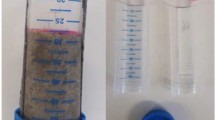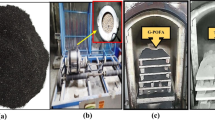Abstract
Optimization of the stabilization materials in terms of their dosage rates specifically used for stabilization applications have become a great interest by the experimenters due to the concerns of strength performance, time and economy for the construction projects. Using a relatively recent optimization technique, Response Surface Methodology (RSM), this paper is mainly focused on investigation of the optimum amounts of stabilizers (Sewage Sludge Ash (SSA) and Polypropylene Fiber (PF)) and Curing Time (CT) that yield to maximum unconfined compressive strength (UCS) for stabilization of a marginal sand (poorly-graded sand). For this purpose, an experimental study has been carried out conducting UCS tests, where the stabilizer proportions are 0-30% for SSA and 0-1% for PF, by total dry weight of sand+SSA. Also, the curing times considered prior to testing are 0, 7 and 14 days. All UCS tests have been performed following the experimental program by central composite design that used the ranges of stabilizer proportions and curing times. On the basis of experimental data, a full quadratic model with natural log transformation and backward analysis has been built through RSM considering the factors of SSA, PF, CT, and the response of UCS. The results indicate that the mathematical model built in this study is statistically significant (p ≤ 0.05) through the analysis of variance (ANOVA), thus it is applicable for optimization process. The findings from the optimization effort demonstrate that the most potential values for SSA, PF and CT are 19.95%, 0.57% and 12.15-day, respectively. The proposed values could be beneficial for the experimenters in practice specifically for preliminary evaluations prior testings of stabilizations.
Similar content being viewed by others
References
ASTMD 5102 (2009). Standard test methods for unconfined compressive strength of compacted soil-lime mixtures, West Conshohocken, PA, USA.
Bayramov, F., Tademir, C., and Tademir, M. A. (2004). “Optimisation of steel fibre reinforced concretes by means of statistical response surface method.” Cement and Concrete Composites, Vol. 26, No. 6, pp. 665–675, DOI: 10.1016/S0958-9465(03)00161-6.
Box, G. E. P. and Wilson, K. B. (1951). “On the experimental attainment of optimum conditions (with discussion).” Journal of the Royal Statistical Society Series B, Vol. 13, No.1, pp. 1–45.
Cai, Y., Shi, B., Ng, C. W. W., and Tang, C. S. (2006). “Effect of polypropylene fibre and lime admixture on engineering properties of clayey soil.” Engineering Geology, Vol. 87, Nos. 3-4, pp. 230–240, DOI: 10.1016/j.enggeo.2006.07.007.
Chavalparit, O. and Ongwandee, M. (2009). “Optimizing electrocoagulation process for the treatment of biodiesel wastewater using response surface methodology.” Journal of Environmental Sciences, Vol. 21, No. 11, pp. 1491–1496, DOI: 10.1016/S1001-0742(08)62445-6.
Chen, L. and Lin, D. F. (2009). “Stabilization treatment of soft subgrade soil by sewage sludge ash and cement.” Journal of Hazardous Materials, Vol. 162, No. 1, pp. 321–327, DOI: 10.1016/j.jhazmat. 2008.05.060.
Consoli, N. C., Bassani, M. A. A., and Festugato, L. (2010). “Effect of fiber-reinforcement on the strength of cemented soils.” Geotextiles and Geomembranes, Vol. 28, No. 4, pp. 344–351, DOI: 10.1016/j.geotexmem.2010.01.005.
Consoli, N. C., Corte, M. B., and Festugato, L. (2012). “Key parameter for tensile and compressive strength of fibre-reinforced soil-lime mixtures.” Geosynthetics International, Vol. 19, No. 5, pp. 409–414.
Consoli, N. C., Moraes, R. R., and Festugato, L. (2013a). “Parameters controlling tensile and compressive strength of fiber-reinforced cemented soil.” Journal of Materials in Civil Engineering, Vol. 25, No. 10, pp. 1568–1573, DOI: 10.1061/(ASCE)MT.1943-5533.0000555.
Consoli, N. C., Scapini, B., and Festugato, L. (2013c). “A practical methodology for the determination of failure envelopes of fiberreinforced cemented sands.” Geotextiles and Geomembranes, Vol. 41, pp. 50–54, DOI: 10.1016/j.geotexmem.2013.07.010.
Consoli, N. C., Zortea, F., Souza, M., and Festugato, L. (2011). “Studies on the dosage of fiber-reinforced cemented soils.” Journal of Materials in Civil Engineering, Vol. 23, No. 12, pp. 1624–1632, DOI: 10.1061/(ASCE)MT.1943-5533.0000343.
Consoli, N.C., Moraes, R. R., and Festugato, L. (2013b). “Variables controlling strength of fibre-reinforced cemented soils.” Proceedings of the Institution of Civil Engineers-Ground Improvement, Vol. 166, No. 4, pp. 221–232, DOI: 10.1680/grim.12.00004.
Correia, A. A. S., Oliveira, P. J. V., and Custodio, D. G. (2015). “Effect of polypropylene fibres on the compressive and tensile strength of a soft soil, artificially stabilized with binders.” Geotextiles and Geomembranes, Vol. 43, No. 2, pp. 97–106, DOI: 10.1016/j.geotexmem. 2014.11.008.
Das, B. M. (2009). Principles of geotechnical engineering, 7th ed., Cengage Learning, USA.
Estabragh, A. R., Namdar, P., and Javadi, A. A. (2012). “Behavior of cement-stabilized clay reinforced with nylon fiber.” Geosynthetics International, Vol. 19, No. 1, pp. 85–92, DOI: 10.1680/gein.2012.19.1.85.
Fletcher, C. S. and Humphries, W. K. (1991). “California bearing ratio improvement of remolded soils by the addition of polypropylene fiber reinforcement.” Transportation Research Record, No. 1295, pp. 80–86.
Güllü, H. (2015). “Unconfined compressive strength and freeze–thaw resistance of fine-grained soil stabilised with bottom ash, lime and superplasticizer.” Road Materials and Pavement Design, Vol. 16, No. 3, pp. 608–634, DOI: 10.1080/14680629.2015.1021369.
Güllü, H. and Hazirbaba, K. (2010). “Unconfined compressive strength and post-freeze–thaw behavior of fine-grained soils treated with geofiber and synthetic fluid.” Cold Regions Science and Technology, Vol. 62, Nos. 2-3, pp. 142–150, DOI: 10.1016/j.coldregions.2010.04.001.
Güllü, H., and Fedakar, H. (2016). “Use of factorial experimental approach and effect size on the CBR testing results for the usable dosages of wastewater sludge ash with coarse-grained material.” European Journal of Environmental and Civil Engineering, DOI: 10.1080/19648189.2016.1179678.
Güneyisi, E., Gesoglu, M., Algýn, Z., and Mermerda, K. (2014). “Optimization of concrete mixture with hybrid blends of metakaolin and fly ash using response surface method.” Composites Part B: Engineering, Vol. 60, pp. 707–715, DOI: 10.1016/j.compositesb.2014.01.017.
Hamidi, A. and Hooresfand, M. (2013). “Effect of fiber reinforcement on triaxial shear behavior of cement treated sand.” Geotextiles and Geomembranes, Vol. 36, pp. 1–9, DOI: 10.1016/j.geotexmem.2012.10.005.
Hazirbaba, K. and Güllü, H. (2010). “California bearing ratio improvement and freeze-thaw performance of fine-grained soils treated with geofiber and synthetic fluid.” Cold Regions Science and Technology, Vol. 63, Nos. 1-2, pp. 50–60, DOI: 10.1016/j.coldregions.2010. 05.006.
Hicks, C. R. (1982). Fundamental concepts in the design of experiments, Rinehart and Winston, New York, USA.
Kaniraj, S. R. and Havanagi, V. G. (2001). “Behavior of cement-stabilized fiber-reinforced fly ash-soil mixtures.” Journal of Geotechnical and Geoenvironmental Engineering, Vol. 127, No. 7, pp. 574–584, DOI: 10.1061/(ASCE)1090-0241(2001)127:7(574).
Khattak, J. and Alrashidi, M. (2006). “Durability and mechanistic characteristics of fiber reinforced soil–cement mixtures.” International Journal of Pavement Engineering, Vol. 7, No. 1, pp. 53–62, DOI: 10.1080/10298430500489207.
Kim, Y. T. and Do, T. H. (2012). “Effect of bottom ash particle size on strength development in composite geomaterial.” Engineering Geology, Vol. 139-140, pp. 85–91, DOI: 10.1016/j.enggeo.2012.04.012.
Kobya, M., Demirbas, E., Bayramoglu, M., and Sensoy, M. T. (2011). “Optimization of electrocoagulation process for the treatment of metal cutting wastewaters with response surface methodology.” Water Air & Soil Pollution, Vol. 215, No. 1, pp. 399–410, DOI: 10.1007/s11270-010-0486-x.
Lin, D. F., Lin, K. L., and Luo, H. L. (2007b). “A comparison between sludge ash and fly ash on the improvement in soft soil.” Journal of the Air & Waste Management Association, Vol. 57, No. 1, pp. 59–64, DOI: 10.1080/10473289.2007.10465294.
Lin, D. F., Lin, K. L., Hung, M. J., and Luo, H. L. (2007a). “Sludge ash/hydrated lime on the geotechnical properties of soft soil.” Journal of Hazardous Materials, Vol. 145, No. 1-2, pp. 58–64, DOI: 10.1016/j.jhazmat.2006.10.087.
Lin, D. F., Luo, H. L., Hsiao, D. H., and Yang, C. C. (2005). “The effects of sludge ash on the strength of soft subgrade soil.” Journal of the Chinese Institute of Environmental Engineering, Vol. 15, No. 1, pp. 1–10.
Murugesan, K., Dhamija, A., Nam, I. H., Kim, Y. M., and Chang, Y. S. (2007). “Decolourization of reactive black 5 by laccase: Optimization by response surface methodology.” Dyes and Pigments, Vol. 75, No. 1, pp. 176–184, DOI: 10.1016/j.dyepig.2006.04.020.
Musenda, C. (1999). Effects of Fiber Reinforcement on Strength and Volume Change Behavior of Expansive Soils, MSc Thesis, University of Texas at Arlington, USA.
Myers, R. H., Montgomery, D. C., and Anderson-Cook, C. M. (2009). Response surface methodology: Process and product optimization using designed experiments, 3rd ed., John Wiley&Sons, New Jersey, USA.
Nasr, A. M. (2014). “Behavior of strip footing on fiber-reinforced cemented sand adjacent to sheet pile wall.” Geotextiles and Geomembranes, Vol. 42, No. 6, pp. 599–610, DOI: 10.1016/j.geotexmem.2014.10.004.
Nordin, M. Y., Venkatesh, V. C., Sharif, S., Elting, S., and Abdullah, A. (2004). “Application of response surface methodology in describing the performance of coated carbide tools when turning AISI 104 steel.” Journal of Materials Processing Technology, Vol. 145, pp. 46–58, DOI: 10.1016/S0924-0136(03)00861-6.
Olgun, M. (2013a). “Effects of polypropylene fiber inclusion on the strength and volume change characteristics of cement-fly ash stabilized clay soil.” Geosynthetics International, Vol. 20, No. 4, pp. 263–275, DOI: 10.1680/gein.13.00016.
Olgun, M. (2013b). “The effects and optimization of additives for expansive clays under freeze-thaw conditions.” Cold Regions Science and Technology, Vol. 93, pp. 36–46, DOI: 10.1016/j.coldregions. 2013.06.001.
Pandian, N. S. and Krishna, K. C. (2002). “California bearing ratio behavior of cement-stabilized fly ash-soil mixes.” Journal of Testing and Evaluation, Vol. 30, pp. 492–496, DOI: 10.1520/JTE12347J.
Park, S. (2009). “Effect of fiber reinforcement and distribution on unconfined compressive strength of fiber-reinforced cemented sand.” Geotextiles and Geomembranes, Vol. 27, No. 2, pp. 162–166, DOI: 10.1016/j.geotexmem.2008.09.001.
Park, S. (2011). “Unconfined compressive strength and ductility of fiberreinforced cemented sand.” Construction and Building Materials, Vol. 25, No. 2, pp. 1134–1138, DOI: 10.1016/j.conbuildmat.2010.07.017.
Pino, L. F. M. and Baudet, B. A. (2015). “The effect of the particle size distribution on the mechanics of fibre-reinforced sands under onedimensional compression.” Geotextiles and Geomembranes, Vol. 43, No. 3, pp. 250–258, DOI: 10.1016/j.geotexmem.2015.02.004.
Pradhan, B. and Bhattacharjee, B. (2009). “Performance evaluation of rebar in chloride contaminated concrete by corrosion rate.” Construction and Building Materials, Vol. 23, No. 6, pp. 2346–2356, DOI: 10.1016/j.conbuildmat.2008.11.003.
Puppala, A. J. and Musenda, C. (2000). “Effects of fiber reinforcement on strength and volume change behavior of expansive soils.” Transportation Research Board 79th Annual meeting, Washington D.C.
ahmaran, M., Bilici, Z., Ozbay, E., Erdem, T. K., Yucel, H. E., and Lachemi, M. (2013). “Improving the workability and rheological properties of engineered cementitious composites using factorial experimental design.” Composites Part B: Engineering, Vol. 45, No. 1, pp. 356–368, DOI: 10.1016/j.compositesb.2012.08.015.
Santoni, L., Tingle, S., and Webster, L. (2001). “Engineering properties of sand–fiber mixtures for road construction.” Journal of Geotechnical and Geoenvironmental Engineering, Vol. 127, No. 3, pp. 258–268, DOI: 10.1061/(ASCE)1090-0241(2001)127:3(258).
Schoefs, F., Le, K. T., and Lanata, F. (2013). “Surface response metamodels for the assessment of embankment frictional angle stochastic properties from monitoring data: An application to harbour structures.” Computers and Geotechnics, Vol. 53, pp. 122–132, DOI: 10.1016/j.compgeo.2013.05.005.
Sen, R. and Swaminathan, T. (1997). “Application of response-surface methodology to evaluate the optimum environmental conditions for the enhanced production surfactin.” Applied Microbiology and Biotechnology, Vol. 47, No. 4, pp. 358–363.
Tang, C., Shi, B., Gao, W., Chen, F., and Cai, Y. (2007). “Strength and mechanical behavior of short polypropylene fiber reinforced and cement stabilized clayey soil.” Geotextiles and Geomembranes, Vol. 25, No. 3, pp. 194–202, DOI: 10.1016/j.geotexmem.2006.11.002.
Tingle, J. S., Webster, S. L., and Santoni, R. L. (1999). Discrete fiber reinforcement of sands for expedient road construction (GL-99-3). U.S. Army Engineer Waterways Experiment Station Vicksburg, MS, USA.
Vasudev, D. (2007). Performance studies on rigid pavement sections built on stabilized sulfate soils, MSc Thesis, University of Texas at Arlington, USA.
Viswanadham, S., Phanikumar, R., and Mukherjee, V. (2009). “Swelling behavior of a geofiberreinforced expansive soil.” Geotextiles and Geomembranes, Vol. 27, No. 1, pp. 73–76, DOI: 10.1016/j.geotexmem. 2008.06.002.
Yetimoglu, T. and Salbas, O. (2003). “A study on shear strength of sands reinforced with randomly distributed discrete fibers.” Geotextiles and Geomembranes, Vol. 21, No. 2, pp. 103–110, DOI: 10.1016/S0266-1144(03)00003-7.
Yetimoglu, T., Inanir, M., and Inanir, O. E. (2005). “A study on bearing capacity of randomly distributed fiber-reinforced sand fills overlying soft clay.” Geotextiles and Geomembranes, Vol. 23, No. 2, pp. 174–183, DOI: 10.1016/j.geotexmem.2004.09.004.
Author information
Authors and Affiliations
Corresponding author
Rights and permissions
About this article
Cite this article
Güllü, H., Fedakar, H.İ. Response surface methodology for optimization of stabilizer dosage rates of marginal sand stabilized with Sludge Ash and fiber based on UCS performances. KSCE J Civ Eng 21, 1717–1727 (2017). https://doi.org/10.1007/s12205-016-0724-x
Received:
Revised:
Accepted:
Published:
Issue Date:
DOI: https://doi.org/10.1007/s12205-016-0724-x




